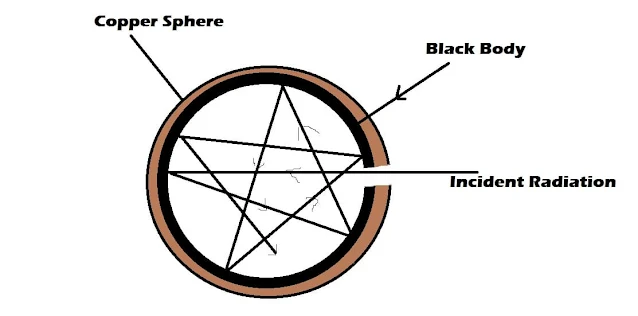A black body concept absorbs all radiation incident upon it, whatever the wavelength, λ. It is an ideal body that absorbs all incident energy and reflects or transmits none. This means that the black body is perfectly non-reflecting and non-transmitting.
Actually, no matter with a = 1 and τ = r = 0 exists. Even the blackest surfaces occurring in nature still have a reflectivity of about 1 percent (r =0.01).
{tocify} $title={Table of Contents}
Hence, although a black body must be back in color, this is not a sufficient condition. Kirchhoff's law, however, conceived the following possibility of making a practically perfect black body. If a hollow body is provided with only one very small opening and is held at a uniform temperature, then any beam of radiation entering through the hole is partly absorbed and partly reflected inside.
The reflected radiation will not find the outlet but will fall again on the inside wall. There it will be only partly reflected and so on. By such a sequence of reflections, the entering radiation will be almost absorbed by the body and an arrangement of this kind will act just as a perfectly black body as shown in the picture.
All substances emit radiation, quality, and quantity depending upon the absolute temperature and the properties of the material composing a radiating body. It may be shown that at a given temperature good absorbers of any particular wavelength are also good emitters of that wavelength.
Thus since by definition, a black body is a complete radiator of all wavelengths it is also the best possible of thermal radiation i.e. it is a full radiator.
Black Body Radiation
A body for which a =1, r = τ = 0, i.e., which absorbs all the incident radiant energy, is called a black body. It neither reflects nor transmits but absorbs all the radiation incident on it, so it is treated as an ideal radiation receiver.
The surface of the body doesn't need to be black in color. The black body radiates the maximum possible amount of energy at a given temperature and though perfectly black bodies do not exist in nature, some materials may approach it. Lampblack is the nearest to a black body. It absorbs 96% of visible light.
Characteristics of Black Body Radiation
Imagine you have a perfect, imaginary object called a "black body." It doesn't actually exist, but it helps us understand certain properties of radiation.
1. Perfect Absorption and Emission
A black body is an object that absorbs all the radiation that falls on it, regardless of its wavelength or color. And when it absorbs this radiation, it also emits radiation in response.
2. No Reflection
Unlike real-world objects, which might reflect some light, a black body doesn't reflect anything, it takes in all the radiation.
3. Wavelength Dependence
The amount and type of radiation a black body emits depends on its temperature. As the temperature increases, the black body emits more radiation at all wavelengths. At higher temperatures, it emits more high-energy (short wavelength) radiation, like ultraviolet and visible light. At lower temperatures, it emits more low-energy (long wavelength) radiation, like infrared.
4. Continuous Spectrum
When a black body is heated, it emits radiation at all wavelengths continuously. This range of radiation covers all colors of light (visible and invisible) as well as other forms of electromagnetic radiation.
5. Thermal Equilibrium
When a black body is placed in a space with no other sources of radiation, it will eventually reach a state called "thermal equilibrium." In this state, the amount of radiation it absorbs equals the amount it emits, and its temperature remains constant.
6. Stefan-Boltzmann Law
The total power (energy per unit time) radiated by a black body is proportional to the fourth power of its temperature. This means that the hotter the black body, the more energy it emits.
The concept of black body radiation is crucial in understanding various phenomena in physics, such as the behavior of stars, the Earth's heat emission, and the study of thermal radiation. It is also fundamental in the development of quantum mechanics and the understanding of the quantization of energy.

